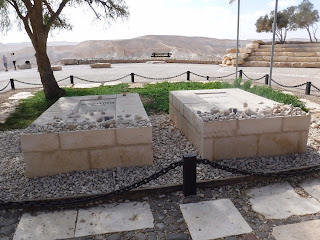October 27, 2018
Friday was a day on the bus. Really disappointing, but I understand the decision. The death toll from the flooding accident in Jordan is now 21, and there are still children missing. And it seems that a young child in the Israeli desert was also swept away by a flood. We will ride with sadness in our hearts for our little brothers and sisters and their families. On the other hand, the day was bright and clear - if a bit windy. It was hard not to ride.
Our bus took us many of the places we would have seen if we were riding. I must admit that the hills are a lot easier on a bus. We visited Sde Boker - the settlement where David Ben Gurion retired and where he and his wife are buried. It sits in the Negev, with majestic vistas of the desert. Ben Gurion understood that the future of the State of Israel lay in taming the desert. He viewed the north and the big cities as limited in space and resources. And as one spends time in both the north and the south, it is easy to see the wisdom of his vision. Alas, the country has not yet caught up. As a result the north grows ever more crowded, and the desert, in all its stark beauty, remains a largely untapped wilderness. This is not to say that there are no flourishing desert towns; there are. It remains a question of balance. But who would not want this vista with their morning coffee?
We also passed an incredible solar field with an array of tens of thousands of mirrors focusing the sun light on a generating tower. It is positively other-worldly in how it glows. Supplying enough power for a small city, this technology is able to generate electricity 2 hours a day by storing the heat that is collected during sun light hours. I have a not-so-good photo that I will replace later with a better one from one of my fellow riders.
And finally we roll into Mitzpe Ramon, the town that sits at the edge of Makhtesh Ramon. Commonly translated as “crater,”. A Makhtesh is a geological formation created by millions of years of water seeping through limestone and washing through the valley. I don’t really understand it, but the sight is absolutely stunning. This is a wonder-of-the-world - visible from outer space.
Shabbat is an official day off for the Ride. The crew (which has been AWESOME in handling the logistical nightmare of the interrupted rides) is off..and generally we do not have access to our bikes. But in an effort to assuage some of the disappointment of the last two days, the bikes have been made available to those of us who want to ride on our own (no support, no mechanics, no food!). I rode with a small group out of town on the road that leads to the Egyptian border, about 25 miles away. We did not ride all the way - but about 17 miles out and then back made for a reasonable consolation prize for missing a day and a half of rides. And if I am completely honest - there were a couple of hills I did not miss! Here is the ride link: https://www.relive.cc/view/g26188107785. And of course a few photos.
And I ended my ride at the Makhtesh.
Later today we will hear from some alumni of the Arava Institute, who will tell us of their work and the impact the Institute has had on their lives - this is alway a highlight of the trip. Then we will gather at the Makhtesh for Havdalah, the service that closes Shabbat and greets the new week. Always a joyful and raucous gathering. Dinner then early to bed, for tomorrow we WILL RIDE!!! Down the steep descent into the Makhtesh - across the floor, tracing the route of the Nabatean spice traders, and out the other side. We end tomorrow night at Kibbutz Ketura, home of the Arava Institute. More on that later.
Later today we will hear from some alumni of the Arava Institute, who will tell us of their work and the impact the Institute has had on their lives - this is alway a highlight of the trip. Then we will gather at the Makhtesh for Havdalah, the service that closes Shabbat and greets the new week. Always a joyful and raucous gathering. Dinner then early to bed, for tomorrow we WILL RIDE!!! Down the steep descent into the Makhtesh - across the floor, tracing the route of the Nabatean spice traders, and out the other side. We end tomorrow night at Kibbutz Ketura, home of the Arava Institute. More on that later.
Until then,
L’hitra-ot









No comments:
Post a Comment